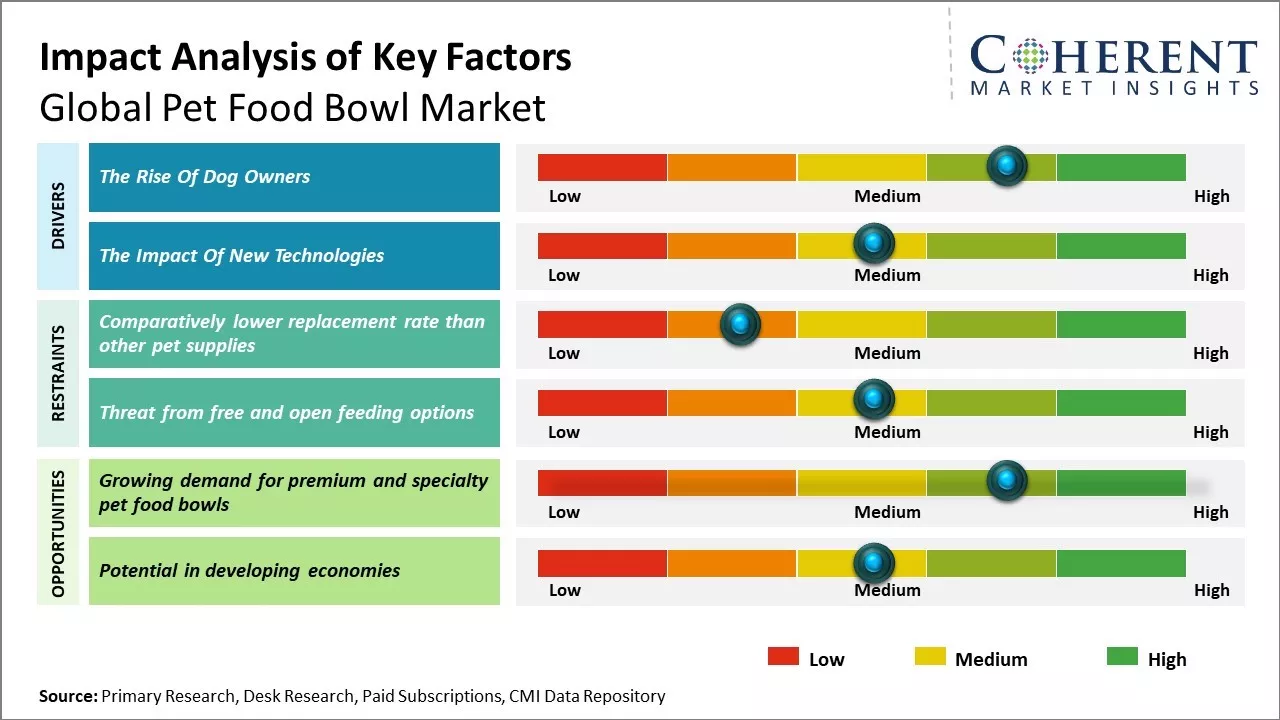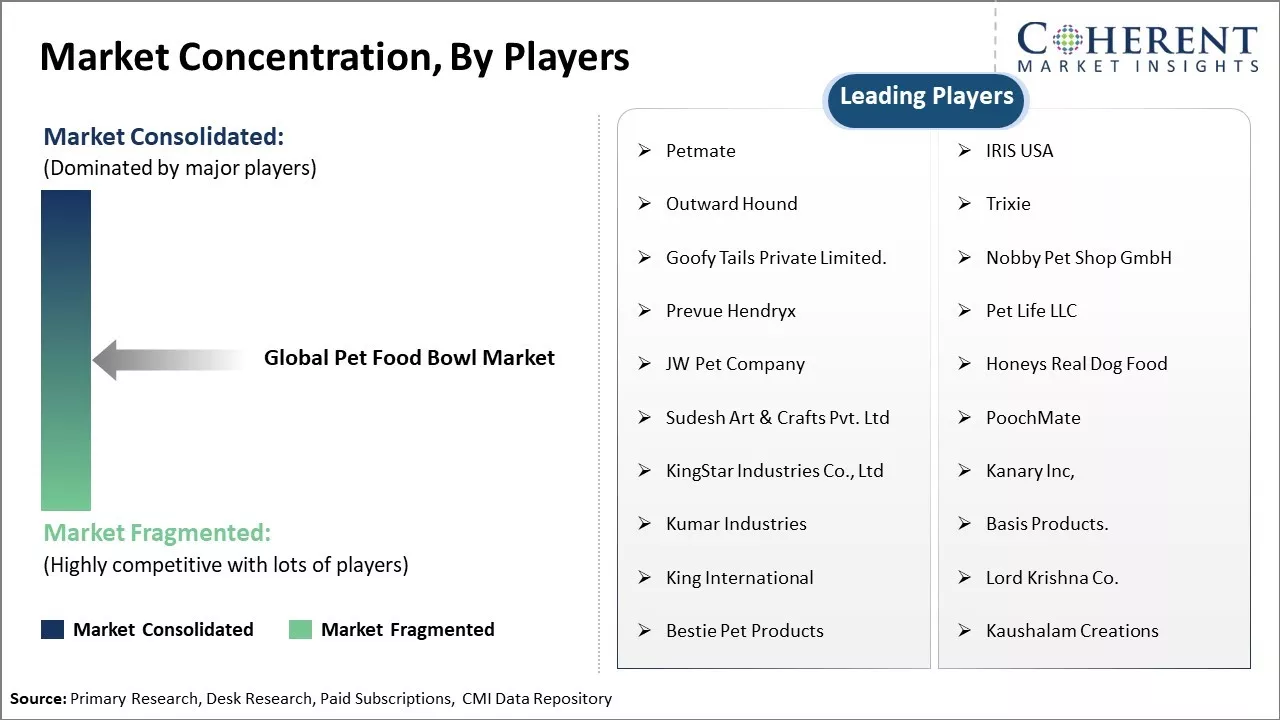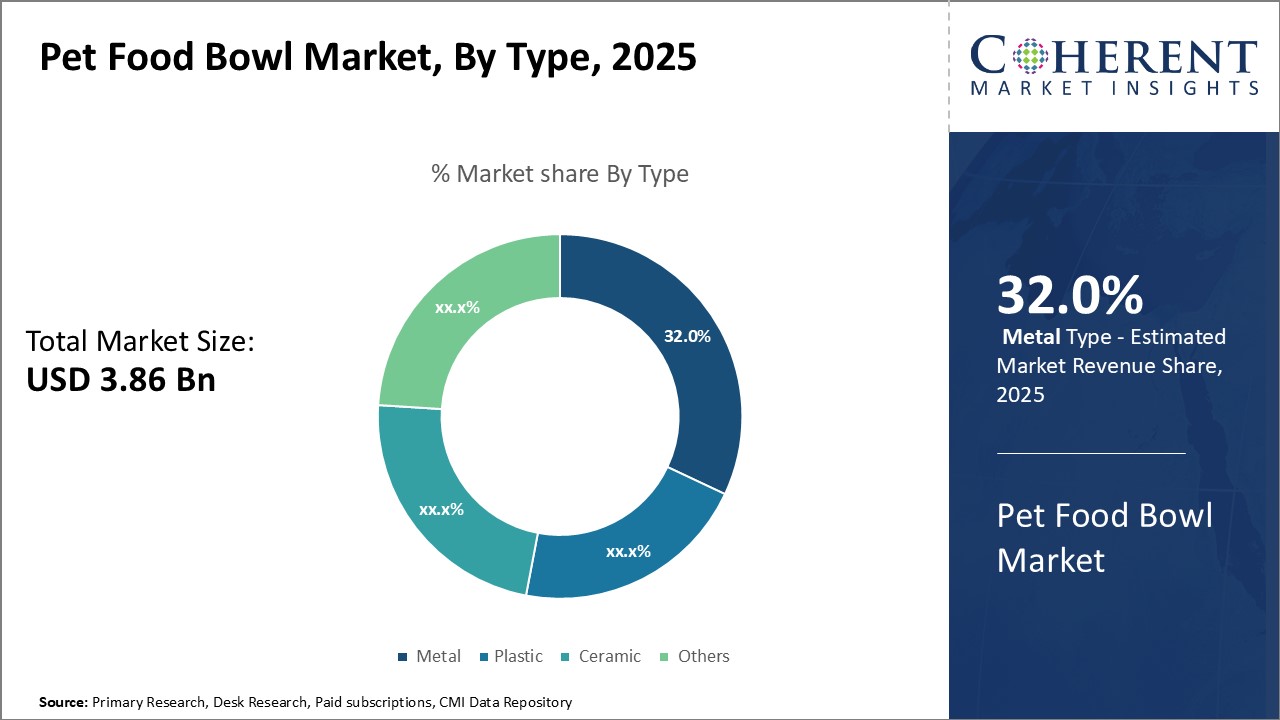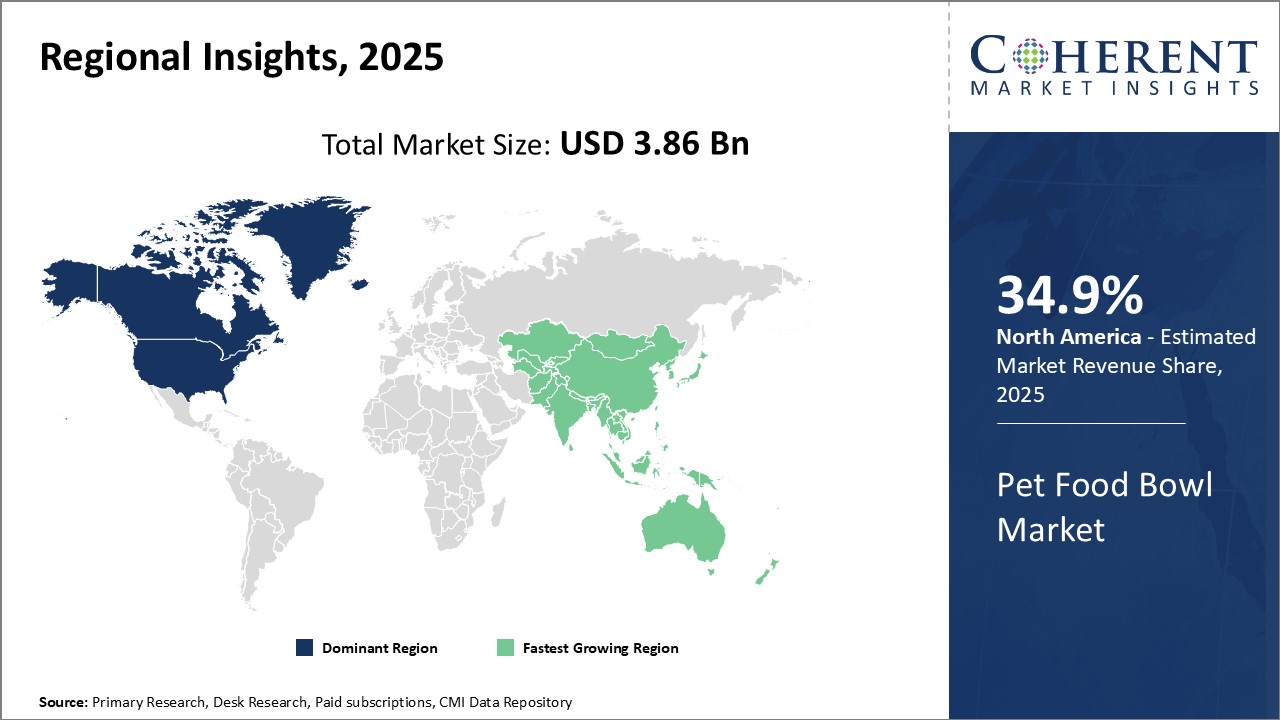The pet food bowl market is estimated to be valued at USD 3.86 Bn in 2025 and is expected to reach USD 5.58 Bn by 2032, exhibiting a compound annual growth rate (CAGR) of 5.4% from 2025 to 2032.

Discover market dynamics shaping the industry: Request sample copy
The pet food bowl market has been witnessing significant growth over the past few years. Rising pet ownership and increasing humanization of pets have been driving more owners to purchase specialized products to feed their pets. Moreover, the growing availability of innovative product varieties incorporating new designs, materials, and sizes to suit different pet needs has further boosted the market growth. With growing awareness about pet health and nutrition, owners are willing to spend more on high-quality bowls and feeders. This trend is expected to continue in the foreseeable future and drive the demand for pet food bowls across various regional markets.
The Rise Of Dog Owners
The pet food bowl market has seen significant growth in recent years due to the rise in dog ownership across the globe. As people increasingly view dogs not just as pets but as companions and members of their family, they are more willing to invest in the needs and comforts of their furry friends. This means pet owners today pay more attention to hygiene, nutrition, and health factors when it comes to feeding their dogs. Dog ownership rates have increased especially in developed nations where people now have smaller families and more disposable income. In U.S. alone, it is estimated that over 50% of households now own a dog, up from less than 40% just 10 years ago. Similar rises have been witnessed in densely populated countries like the U.K., Japan, and large parts of Europe as well. With over 75 million homes now owning a dog in the U.S. that translates to a huge customer base for everything related to daily dog care, including feed bowls. Alongside the numbers, attitudes have evolved too. Where dogs were traditionally seen as working animals or outdoor pets, today's dog owners want to integrate their dogs indoors and treat them almost like children. This reflects in how they feed their dogs - instead of simply dumping food and water on the floor, owners want aesthetic and practical bowls that preserve hygiene, keep mess to a minimum and add a touch of style. Materials like ceramic, stainless steel, and silicone cater to both human preferences and dog needs. The rise of smaller nuclear families means dogs also fill a void for companionship and affection. Their well-being matters tremendously to owners who want the best food, toys, healthcare and other amenities for their canine friends. This mentality will continue driving the demand for things like innovative bowls with non-slip, spill proof and easy-clean features.

Get actionable strategies to beat competition: Request sample copy
The Impact Of New Technologies
While traditional dog food bowls continue meeting basic needs, new technologies are introducing exciting functionalities that further drive the market. Pet tech has made huge advancements in recent years with smart devices, location trackers, and AI-powered apps poised to transform the pet care experience. This revolution is also impacting how owners perceive and purchase bowls.
Key Takeaways from Analyst:
North America currently dominates the market due to high pet ownership rates. Growing humanization of pets and increased willingness of owners to spend on high-quality pet products will drive bowl sales. Premium bowls made from ceramic or stainless steel that are stylish, dishwasher-safe, and prevent messes are gaining popularity. However, low replacement rates remain a challenge as most bowls last years with proper care.
Changing lifestyles and more singles are fueling demand for portable, lightweight travel bowls that are easy to clean. Bowls with integrated filters help reduce messes and are particularly appealing to busy owners. Growth opportunities also exist in designing bowls for specialty diets and pets with medical issues. Novel designs focused on fun for pets could captivate owners seeking to enrich their pet's lives. Rising pet obesity as more owners overfeed their pets may stimulate demand for portion-controlled, calorie-counting bowls.
Online shopping continues expanding the market reach beyond brick-and-mortar pet stores. Private label offerings are gaining competitively priced yet innovative options. However, proliferation of low-quality imported bowls remains a concern. Overcrowding in the standard bowl segment makes compelling new product development crucial.
Market Challenges: Comparatively lower replacement rate than other pet supplies
The replacement rate of pet food bowls in the global market has been relatively lower compared to other pet supplies like toys, grooming products and apparel, which is one of the major factors restraining the growth of the global pet food bowl market. Pet food bowls generally have a longer usage lifespan if proper care is taken, and pet owners do not feel the need to replace them as frequently as other pet products. Most pet food bowls, if made of durable materials like stainless steel or ceramic, can last for several years with regular cleaning and maintenance. Plastic and rubber feeders also have a long life if not destroyed by the pet. As a result, the replacement cycle for food bowls tends to be every 2-3 years for the average pet. In contrast, items like toys see replacement every 6-12 months as pets tend to destroy them more quickly through chewing and play. Even grooming supplies like brushes and combs need periodic refills or replacement in 1-2 years.
Market Opportunities: Growing demand for premium and specialty pet food bowls
The global pet food bowl market is poised to benefit significantly from the growing demand for premium and specialty pet food bowls. Over the past few years, pet ownership has risen considerably worldwide with people increasingly viewing their pets as companions and family members. This has translated into higher spending on quality pet foods and accessories. Pet owners now want functional yet aesthetically appealing bowls for their furry friends made of safer materials like stainless steel and ceramic rather than just plastic. There is growing awareness about the health impact of BPA, melamine and other toxic chemicals that are present in many regular plastic pet bowls. More manufacturers are introducing premium, non-toxic options in different designs, sizes and portable models to suit various pets and lifestyles. Customized bowls engraved with names or paw prints have also become popular gift items.

Discover high revenue pocket segments and roadmap to it: Request sample copy
Insights by Type: Durability and Value for Money Drive the Demand for Metal Pet Food Bowls
Metal segment is expected to contribute the highest share to the overall pet food bowl market due to their renowned durability and value for money. Metal bowls can withstand the constant wear and tear from pets chewing, scratching, and pushing around their food bowls multiple times a day. Their sturdy construction means they will not break, chip, or deform over long-term use like plastic or ceramic bowls can. Pet owners appreciate how metal bowls maintain their shape and functionality through the lifetime of caring for multiple pets. The density and heft of metal also means food and water bowls are much less likely to be tipped over accidentally by enthusiastic pets. This not only helps keep mealtimes mess-free but prevents wastage of food. Metal conducts temperatures nicely as well, so bowls can be popped in the fridge to provide cooling water or warmed slightly for food, making it a safe and suitable material for pets. From a cost perspective, metal bowls offer outstanding value for money compared to other materials. While the initial purchase price may be only marginally higher than plastic, metal bowls can be reused indefinitely without replacement. Over many years of continuous use, the amortized cost per bowl works out to be much lower than plastic which needs periodic throws. Some metal bowl options are also dishwasher safe for easy cleaning. All of these advantages drive consistent consumer preference and market leadership for metal in the pet food bowl segment.
Insights by Pet Type: Canines' Natural Instincts Fuel the Dog Segment Dominance
It comes as no surprise that the dog segment contributes the 42.7% share to the pet food bowl market in 2025. As humankind's most historical companion, dogs have been bred over centuries to form deep bonds with humans through cooperation, communication and shared living quarters. Several inherent canine traits cement dogs' status as the preferred family pet for a majority of households and fuel outsized demand for dog-focused products like food bowls. Dogs are naturally pack animals with strong social needs. They thrive on the company and bonding activities of living alongside humans. Meanwhile, their territorial instincts elicit protective reactions towards guarding the home and family unit. Food specifically holds associations with bonding, and dogs enjoy "sharing" mealtimes near their pet parents. Food bowls satisfy dogs' needs for designated feeding stations as an extension of their natural pack roles

Need a Different Region or Segment? Customize now
North America has established itself as the dominant region in the global pet food bowl market. The region is expected to account for a market share of 34.9% in 2025. The large pet population combined with higher disposable incomes in countries like the U.S. and Canada have fueled market growth. North American consumers are willing to spend on premium pet products that promise better functionality and design. Several major pet food bowl manufacturers have established production facilities as well as distribution networks extensively across the region allowing for easy access to products. The presence of pioneering brands in the region like Petmate and Lixit has set industry standards in terms of quality and innovation. These players have also supported market growth through extensive branding and promotional activities over the years. E-commerce has emerged as a prominent sales channel for pet products including food bowls. Online retailing platforms in North America offer consumers convenience in purchase alongside options to choose from a wide variety.
Switching focus to another region, Asia Pacific has emerged as the fastest growing market for pet food bowls globally. The economic development of countries like China, India, and certain Southeast Asian nations is a major factor. As per-capita incomes rise, people are willing to spend more on pets. This includes opting for high-quality consumables such as specialized food bowls. Simultaneously, there is a surge in nuclear families giving rise to lone pet owners. This is encouraging individualized caring and feeding practices rather than communal set-ups. Rising organized retailing of pet products through multi-brand stores and e-tailers in Asia Pacific metropolitan areas is improving access for consumers. Local manufacturers are also establishing themselves by offering affordable as well as premium product ranges. This is attracting modern pet owners in the region. The growth potential has even driven international brands to court Asian markets through tailored strategies of licensing, joint ventures, and imports. Overall, these macro and industry-specific trends place Asia Pacific as an area of focus for the future.
Pet Food Bowl Market Report Coverage
| Report Coverage | Details | ||
|---|---|---|---|
| Base Year: | 2024 | Market Size in 2025: | USD 3.86 Bn |
| Historical Data for: | 2020 To 2024 | Forecast Period: | 2025 To 2032 |
| Forecast Period 2025 to 2032 CAGR: | 5.4% | 2032 Value Projection: | USD 5.58 Bn |
| Geographies covered: |
|
||
| Segments covered: |
|
||
| Companies covered: |
Petmate, IRIS USA, Outward Hound, Trixie, Goofy Tails Private Limited., Nobby Pet Shop GmbH, Prevue Hendryx, Pet Life LLC, JW Pet Company, Honeys Real Dog Food, Sudesh Art & Crafts Pvt. Ltd, PoochMate, KingStar Industries Co., Ltd, Kanary Inc, Kumar Industries, Basis Products., King International, Lord Krishna Co., Bestie Pet Products, and Kaushalam Creations |
||
| Growth Drivers: |
|
||
| Restraints & Challenges: |
|
||
Uncover macros and micros vetted on 75+ parameters: Get instant access to report
*Definition: The pet food bowl market consists of companies that manufacture ceramic, stainless steel, and plastic food and water bowls for domestic pets such as dogs and cats. Key products in this market include elevated food bowls designed to prevent bloat, slow feeding bowls that discourage rapid eating, interactive food toys, auto-fill water bowls, and portable bowls for on-the-go feeding. Companies in this market aim to develop innovative, durable, and affordable solutions to help pet owners easily and hygienically feed their pets.
Share
Share
About Author
Yash Doshi is a Senior Management Consultant. He has 12+ years of experience in conducting research and handling consulting projects across verticals in APAC, EMEA, and the Americas.
He brings strong acumen in helping chemical companies navigate complex challenges and identify growth opportunities. He has deep expertise across the chemicals value chain, including commodity, specialty and fine chemicals, plastics and polymers, and petrochemicals. Yash is a sought-after speaker at industry conferences and contributes to various publications on topics related commodity, specialty and fine chemicals, plastics and polymers, and petrochemicals.
Missing comfort of reading report in your local language? Find your preferred language :
Transform your Strategy with Exclusive Trending Reports :
Frequently Asked Questions
Joining thousands of companies around the world committed to making the Excellent Business Solutions.
View All Our Clients
US Reciprocal Tax Impact Analysis On Pet Food Bowl Market
Stay updated on tariff changes with expert insights and timely information